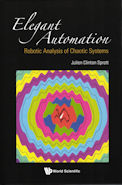This text provides an introduction to the exciting new developments in chaos and related
topics in nonlinear dynamics, including the detection and quantification of chaos in experimental
data, fractals, and complex systems. Most of the important elementary concepts in nonlinear
dynamics are discussed, with emphasis on the physical concepts and useful results rather than
mathematical proofs and derivations. While many books on chaos are purely qualitative and
many others are highly mathematical, this book fills the middle ground by giving the essential
equations, but in the simplest possible form. It assumes only an elementary knowledge of calculus.
Complex numbers, differential equations, and vector calculus are used in places, but those tools
are described as required. The book is aimed at the student, scientist, or engineer who wants to
learn how to use the ideas in a practical setting. It is written at a level suitable for advanced
undergraduate and beginning graduate students in all fields of science and engineering.



